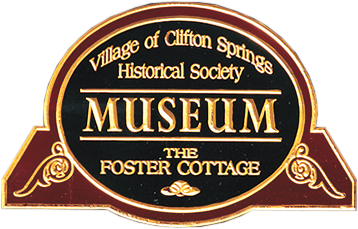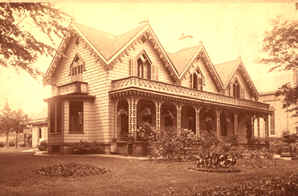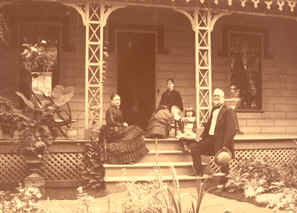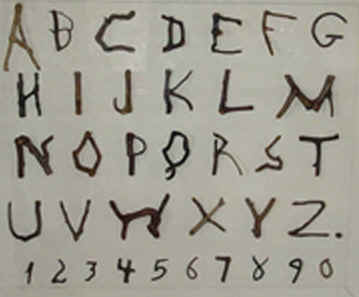Virtual Tour of Foster Cottage Museum
The best way to fully experience the beauty of Foster Cottage is to visit it. We would be very happy to give you a personal tour, so please stop by. However, in the meantime, enjoy our virtual tour of some of the rooms at foster cottage. Follow the link at the end of each page to go to next room on the tour.
Welcome to the Foster Cottage, the home of Dr. Henry Foster and his wife. The building was constructed about 1854 as a social center for the doctor
and his guests. He did not live in the residence to begin with, as he preferred to have rooms in his Water Cure Facility. Early residents were his
brothers, Hubbard and William Foster. When Dr. Foster married Mary Edwards, in June of 1872, they moved here and remained in the cottage the balance
of their lives with the exception of winter trips to Florida.
The house is unique in that the siding gives the appearance of stone although it is made of wood. The home of George Washington at Mount Vernon in
Virginia is made of like material. The wood is said to be "rusticated' or given the appearance of stone blocks. How the doctor heard of his type of
construction is unknown, but over the years it has withstood the demands of time. Today it is a special Victorian center for village history.
After Mrs. Foster's death in 1916, the cottage became the home of the superintendents of the medical facility Dr. Foster had founded here in 1850.
Sometime later, incoming doctors to the facility made it a temporary residence until they could obtain local property. In more recent years, the
interior was made over into 4 apartments. Unfortunately we have no original plans so rooms do not conform to the same outlines as you find them today.
With plans and funds from by Mr.& Mrs. I. A. Morris, the building was divided into two separate units. This front section now serves as a museum for the
Clifton Springs Historical Society. The rear section was retained as an apartment for the home of the manager of Spa. Apartments. (the old, main building
which was part of the original 1896 Sanitarium erected by Dr. Foster.)
Much of the exterior has retained its original construction but parts of the building that had fallen into disrepair have been renewed and strengthened.
The window treatments, the glass door panels, the fireplaces and the staircase banister are all original to the building.
Foster Cottage Museum contains four main rooms on the first floor with an additional four rooms on the second floor. Located on the west rear of the 1"
floor are a handicapped entrance, a small kitchen area and a rest room. On the second floor, the main room to the rear has been done over for an office
and the remaining 3 rooms utilized for display purposes. Also on this level are two small areas used for the storage of the holdings of the historical society.
EAST ROOM-DOWNSTAIRS-RECEPTION
On entering the Foster Cottage Museum, you find yourself in a hall with stairs to the second floor ahead of you. The first room on the left, which
probably served as a parlor or sitting room, has been converted to a reception area for the museum.
Here you will find on three of the walls panels telling some of the history of the hospital and the village itself. It was put together by historical
society member and past president, Jim Conners on the occasion of the 150 Anniversary of the founding of the first Water Cure here by Dr. Henry Foster
in 1850. It is hoped that visitors will take the time to view these several panels for a quick look at some of the highlights of the community.
The first settlers within the village were the Shekell family from Frederick Co. in Maryland. They arrived in 1801/02 and built their first log cabin
on top of East Hill now property of the Episcopal Church.
The village was first known as Sulphur Springs due to its mineral springs, which ran through the village. By the time Dr. Foster arrived in 1850 it was
already known as Clifton Springs. We have been unable to discover how or why that name was adopted as no one by the name of Clifton lived here. It is
surmised that as the village lies in a hollow between two hills the name relates to "cliff town." The Post Office here began in 1849.
...A NATURE COLLECTION...
COLLECTING CROOKED STICKS
It is said that every man has, or should have, a fad. Among these are many collectors, but who ever heard of a man collecting crooked sticks? We find
such a man in the person of E. A. Miles, a treasurer of the Clifton Springs Sanitarium. His goal was to collect all the letters of the alphabet as
found in Mother Nature herself. This he succeeded in doing as you see from the display herewith. He only used one root in all of the 16 letters.
In addition to the letters, a complete set of numerals were obtained in the same way, having be from trees or bushes in the immediate vicinity of Clifton Springs.
Few pieces of the original Foster furnishings have survived. The gold chairs in the reception area were used in the old 1896 building, which early in the 1970's was
converted into 119 senior citizens apartments.
We request that all of our visitors sign our guest book before leaving. We have for sale in this room several photos, postcards and mementos. We charge no fee to
visit the museum but hope that visitors will contribute donations as they see fit. All funds so received go to maintain the museum.
The room provides a pleasant outlook east towards Dr. Foster's final set of buildings. Between runs the famous sulphur stream, which brought the village to life.
He and his wife surely entertained their numerous friends and guests in this lovely East Room.




